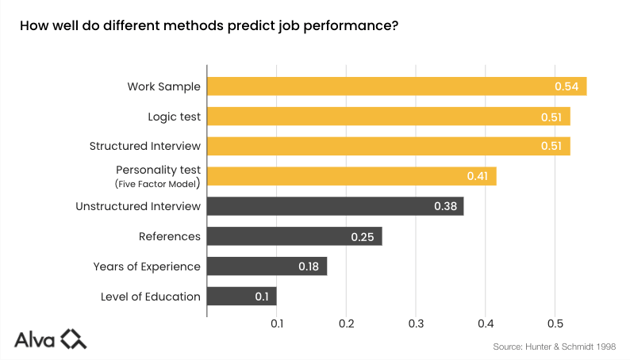What is the difference between structured and unstructured interviews?
Around 85% of hiring managers rely on their gut feeling to make decisions about candidates. This is a problem at every stage of the interview process, particularly during CV screening where women and People of Colour face anything from a 30 - 50% lower call-back rate.
Before we dive deeper, here are some basic definitions:
Unstructured interviews: the main focus is on allowing the conversation to flow. Some questions might be drawn up by recruiters ahead of the interview, but they are asked based on of the conversation with no concrete form.
Structured interviews: interviewers have planned and written a set of standardised questions, the types of answers they’re looking for, and how to rate the responses given by the candidates based on predetermined criteria. All candidates receive the same set of questions in the same order, with less of an opportunity for the conversation to be spontaneous compared to unstructured interviews. Also, all responses are evaluated using the same criteria or scale.
Even though unstructured interviews are more commonly used across industries, there is a consensus that a standardised process provides higher quality information about the candidate - and therefore are more likely to help recruiters to make better decisions.
Why are structured interviews effective?
Imagine you're part of an interviewing panel and your interviewing process is random and unstructured. You have two shortlisted candidates who are interviewing for the same position. One of them shares similar interests, went to the same University, and gets all your jokes. Without a structured interview process, guess which candidate will most likely get picked, regardless of whether the other candidate is also perfectly qualified? This is called affinity bias, which basically means, "similar-to-me" bias, and it's just one of many biases that can happen if your interviewing process is random.
A key way to make an accurate and fair hire is to have structured interviews in place. According to research, structured interviews are twice as effective at predicting job performance than unstructured ones, where hiring managers typically follow their gut instinct. Structured interviews help you reduce confirmation bias in your hiring, as each candidate is assessed the same way using the same criteria.
Tip: When it comes to your hiring process, adopting a structured interview framework will enable you to land the right hires. Map out your structured interview with our free template.
Benefits of a structured interview
When it comes to structured interviews, there are a myriad of benefits to take note of.
Better predictability
Structured interview questions are more effective at capturing how well the candidate will perform in the role.

We tend to overestimate how good we are at instinctively assessing people. Harvard Business Review found that regarding hiring decisions, data-based hiring methods always outperformed human instincts by at least 25% - even in cases when humans had more information about the candidate.
Ease and fairness in assessing candidates
Organizational psychology researchers at Lund University, Wolgast, Björklund & Bäckström claim that differences in the kinds of questions posed to candidates can result in different types of information to be gathered. Some candidates could be asked questions that allow them to demonstrate skills that are relevant to the role, while others may get questions that might highlight their shortcomings.
As each candidate is questioned differently, the interviewer cannot have an accurate bird’s eye view of interviewees. There are no baseline criteria from which to judge their responses, as no baseline has been set.
And since all candidates are asked the same set of questions, interviewee responses can be measured against a baseline, checked against the pre-decided criteria, and compared to each other. The problems of comparability and unfairness do not arise.
Irrelevant traits such as gender, ethnicity, weight, height, perceived attractiveness can - and do - make an impression on the interviewer. Wolgast, Björklund & Bäckström found that people of a different ethnicity from the interviewer tend to be asked less job-relevant questions than those of the same ethnicity.
In unstructured interviews, people of different ethnicities are more likely to be asked questions about their culture or hobbies. That gives them fewer opportunities to illustrate their potential for the job if they don't have the opportunity to answer situational questions. There is also evidence that unstructured interviews result in lower interview scores for applicants that are obese, pregnant, or have disabilities.
Standardising the process and making interviews structured allows for objective questions, and allows for less unconscious bias to derail the hiring decisions. In this way, hiring managers assess candidates using data, not emotion.
Improved candidate experience
When Google researched the use of structured interviews internally, they found that teams using a standardised format with candidates saw an increase in candidate satisfaction in feedback scores. In fact, rejected candidates were 35% happier if they had experienced the same set of predetermined questions versus those who had not.
This links to the growing importance of candidate experience - IBM have found that, when candidates are satisfied with their experience of the recruitment process, they were 38% more likely to accept a job offer and 80% of people were likely to apply for another position in the company.
Being transparent with candidates about the use of standardised interview questions can reassure them that they are being given the same opportunities as others. It gives you the option of providing the candidate with examples of the type of questions you will be asking them ahead of the interview, allowing them to prepare and feel more confident. This in turn can decrease nervousness, allowing them to demonstrate their work skills - rather than their performance skills.
And finally, when interviews tend to be more deliberate and strategic, time gets optimised too, so that candidates can spend more time discussing the role and company with the hiring manager, as opposed to answering generic questions that do little to highlight the candidate's competencies.
Planning interviews well saves you time
Since unstructured interviews are similar to spontaneous conversations, they are unlikely to be the most efficient use of time: interviewers may need to double back if they realise they haven’t received enough information from the candidate - adding extra time and stress to each interview.
Knowing the answers you want might sound controlling. What it means is that, if a candidate gets stuck or doesn’t understand a question (say, if they are being interviewed in a non-native language, or they have a disability), the interviewer can reframe the question.
A structured process also provides a sound basis for providing feedback to unsuccessful candidates, as recruiters can point to what the successful candidate demonstrated, and how that was a better fit for the job.
Google’s internal research found that interviewers were saving an average of 40 minutes per interview, and reported feeling more prepared when interviewing the candidate.
Now you know why you should be using structured interviews in your hiring process - but how do you go about creating them?
Create your own structured interviews
Structured interviews can be one of the superpower methods in your recruitment toolbox. To help you create your own structured interviews, we've created a free template to help you create new processes, and guide you on how to write questions that uncover soft skills.
Just click below for your super-simple Google template, ready to help you get structured and find the best, most diverse and top talent.
Copy your guide below 👇👇






